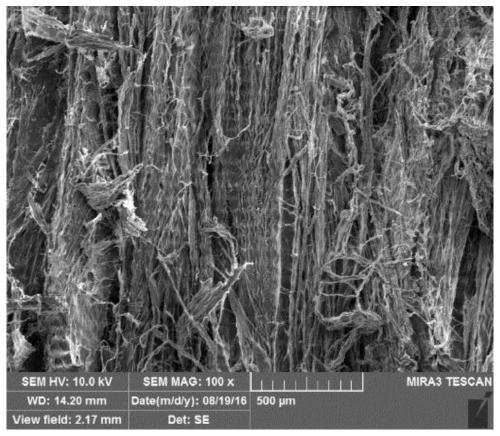Biological repair mesh and preparation method and application thereof
A mesh and biological technology, applied in the field of biological repair mesh and its preparation, can solve problems such as mechanical strength decline, body recurrence, and immune safety problems
- Summary
- Abstract
- Description
- Claims
- Application Information
AI Technical Summary
Problems solved by technology
Method used
Image
Examples
preparation example Construction
[0036] see figure 1 , the preparation method of the biological repair mesh of one embodiment, comprises the following steps:
[0037] Step S110: Slice the animal tendon tissue along the fiber axis, then freeze and thaw repeatedly, and roll and age after rethawing to obtain collagen fiber bundles.
[0038] Wherein, the animal is a mammal. The content of type I collagen is the highest in the tendon tissue of animals, and the fiber bundles are arranged in an orderly manner, while other tissues such as ligaments, peritoneum, and dermis contain elastic fibers and type III collagen, which are non-directional and disorderly arranged. The directional arrangement of collagen fiber bundles provides the basis for the subsequent steps of spreading and weaving.
[0039] Specifically, the slices have a thickness of 1 mm to 5 mm. The number of times of repeated freezing and thawing was 3 to 8 times. During the repeated freezing and thawing steps, the freezing temperature is -80°C to -60°...
Embodiment 1
[0072] The preparation process of the biological repair mesh of the present embodiment is as follows:
[0073] (1) Preparation of collagen fiber bundles: the animal tendon tissue was sliced along the fiber axis, with a slice thickness of 3 mm. Repeated low-temperature freeze-thaw 5 times, low-temperature quick-freezing temperature: -80°C. After remelting, carry out rolling for 2 times, aging at 4°C for 4 hours after rolling each time, and separate fiber bundles after aging to remove broken fiber bundles.
[0074] (2) Collagen fiber bundles to remove immunogenic factors: first soak collagen fiber bundles in 0.1M sodium hydroxide solution for 8 hours, then wash them with purified water until neutral; then use 1.5% TritonX-100 aqueous solution to soak collagen Fiber bundles for 4 hours, then washed with purified water; then soak collagen fiber bundles with 0.2M hydrochloric acid solution for 8 hours, and then washed with purified water until neutral; finally use Tris lye with ...
Embodiment 2
[0078] The preparation process of the biological repair mesh of the present embodiment is as follows:
[0079] (1) Preparation of collagen fiber bundles: the animal tendon tissue was sliced along the fiber axis, with a thickness of 5 mm. Repeated low-temperature freezing and thawing 8 times, low-temperature quick-freezing temperature: -60°C. After remelting, roll pressing is carried out once, and after each roll pressing, it is aged at 2°C for 2 hours. After aging, fiber bundles are separated to remove broken fiber bundles.
[0080] (2) Collagen fiber bundles to remove immunogenic factors: first use 1.0M sodium hydroxide solution to soak collagen fiber bundles for 4 hours, then wash with purified water until neutral; then use 2% Tween-60 aqueous solution to soak Collagen fiber bundles, the time is 6h, then washed with purified water; then use 0.5M acetic acid solution to soak the collagen fiber bundles, time is 6h, and then wash with purified water until neutral; finally us...
PUM
| Property | Measurement | Unit |
|---|---|---|
| Thickness | aaaaa | aaaaa |
| Concentration | aaaaa | aaaaa |
Abstract
Description
Claims
Application Information
 Login to View More
Login to View More - R&D
- Intellectual Property
- Life Sciences
- Materials
- Tech Scout
- Unparalleled Data Quality
- Higher Quality Content
- 60% Fewer Hallucinations
Browse by: Latest US Patents, China's latest patents, Technical Efficacy Thesaurus, Application Domain, Technology Topic, Popular Technical Reports.
© 2025 PatSnap. All rights reserved.Legal|Privacy policy|Modern Slavery Act Transparency Statement|Sitemap|About US| Contact US: help@patsnap.com



